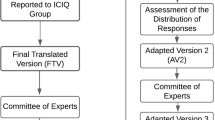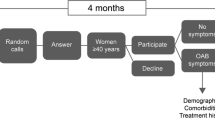Abstract
The purpose of this study was to evaluate the prevalence of overactive bladder (OAB) in a Korean national community sample of adults aged 40–89 years. A national Korean telephone survey using quota sampling methods was conducted. A clinically validated computer-assisted telephone interview approach was used in the survey. In 2,005 subjects (1,005 women and 1,000 men) interviewed, the prevalence of OABwet increased with age in both men and women but OABdry did not. OABdry of men and women was not different in each age decade but OABwet was more common among women than men aged <70 years. Multivariate analysis indicated that sex, age and body mass index (BMI) were associated with OABdry. For OABwet, sex and age were independent risk factors but BMI was not. In multivariate analysis, urgency was not associated with an increased likelihood of the impact on sexual life in men. The likelihood of the impact on sexual life, quality of life (QOL) and willingness to seek medical consultation was not related to nocturia. In female subjects, odds ratios for the impact of daily living, sexual life, QOL, and willingness to seek help from a health professional were not increased for nocuria. The likelihood of the impact on sexual life and willingness to seek medical help was not related to urge incontinence. Our study provides a valuable insight into the need for tailored education to this population about OAB. These findings suggest that there are cross-cultural differences for adapting OAB symptoms.
Similar content being viewed by others
References
Abrams P, Cardozo L, Fall M, Griffiths D, Rosier P, Ulmsten U, van Kerrebroeck P, Victor A, Wein A; Standardisation Sub-committee of the International Continence Society (2002) The standardization of terminology of lower urinary tract function: report from the Standardisation Subcommittee of the International Continence Society. Neurourol Urodyn 21:167–178
Simeonova Z, Milsom I, Kullendorff AM, Molander U, Bengtsson C (1999) The prevalence of urinary incontinence and its influence on the quality of life in women from an urban Swedish population. Acta Obstet Gynecol Scand 78:546–551
Hunskaar S, Vinsnes A (1991) The quality of life in women with urinary incontinence as measured by the sickness impact profile. J Am Geriatr Soc 39:378–382
Hannestad YS, Rortveit G, Sandvik H, Junskaar S (2000) A community-based epidemiological survey of female urinary incontinence: The Norwegian EPINCONT study. Epidemiology of incontinence in the county of Nord-Trondelag. J Clin Epidemiol 53:1150–1157
Stewart WF, Van Rooyen JB, Cundiff GW, Abrams P, Herzog AR, Corey R, Hunt TL, Wein AJ (2003) Prevalence and burden of overactive bladder in the United States. World J Urol 20:327–336
Milsom I, Abrams P, Cardozo L, Roberts RG, Thuroff J, Wein AJ (2001) How widespread are the symptoms of an overactive bladder and how are they managed? A population-based prevalence study. BJU Int 87:760–766
Irwin DE, Milsom I, Hunskaar S, Reilly K, Kopp Z, Herschorn S, Coyne K, Kelleher C, Hampel C, Artibani W, Abrams P (2006) Population-based survey of urinary incontinence, overactive bladder, and other lower urinary tract symptoms in five countries: results of the EPIC study. Eur Urol 50:1306–1014
Moorthy P, Lapitan MC, Quek PL, Lim PH (2004) Prevalence of overactive bladder in Asian men: an epidemiological survey. BJU Int 93:528–531
Chen GD, Lin TL, Hu SW, Chen YC, Lin LY (2003) Prevalence and correlation of urinary incontinence and overactive bladder in Taiwanese women. Neurourol Urodyn 22:109–117
Abrams P, Kelleher CJ, Kerr LA, Rogers RG (2000) Overactive bladder significantly affects quality of life. Am J Manag Care 6(11 Suppl):S580–S590
Komaroff AL, Fagioli LR, Doolittle TH, Gandek B, Gleit MA, Guerriero RT, Kornish RJ 2nd, Ware NC, Ware JE Jr, Bates DW (1996) Health status in patients with chronic fatigue syndrome and in general population and disease comparison groups. Am J Med 101:281–290
Brown JS, Subak LL, Gras J, Brown BA, Kuppermann M, Posner SF (1998) Urge incontinence: the patient’s perspective. J Womens Health 7:1263–1269
Lenderking WR, Nackley JF, Anderson RB, Testa MA (1996) A review of the quality-of-life aspects of urinary urge incontinence. Pharmacoeconomics 9:11–23
Kobelt G (1997) Economic considerations and outcome measurement in urge incontinence. Urology 50(Suppl 6A):100–107
Johansson C, Hellstrom L, Ekelund P, Milsom I (1996) Urinary incontinence: a minor risk factor for hip fractures in elderly women. Maturitas 25:21–28
Stewart RB, Moore MT, May FE, Marks RG, Hale WE (1992) Nocturia: A risk factor for falls in the elderly. J Am Geriatr Soc 40:1217–1220
Weiss JP, Blaivas JG (2000) Nocturia. J Urol 163:5–12
Asplund R (1999) Mortality in the elderly in relation to nocturnal micturition. BJU Int 84:297–301
Eckhardt MD, van Venrooij G, van Melick HH, Boon TA (2001) Prevalence and bothersomeness of lower urinary tract symptoms in benign prostatic hyperplasia and their impact on well-being. J Urol 166:563–568
Swithinbank LV, Abrams P (2000) A detailed description, by age, of lower urinary tract symptoms in a group of communitydwelling women. BJU Int 85:19–24
Mansson A, Caruso A, Capovilla E, Colleen S, Bassi P, Pagano F, Mansson W (2000) Quality of life after radical cystectomy and orthotopic bladder substitution: a comparison between Italian and Swedish men. BJU Int 85:26–31
Acknowledgments
This study was supported by the Korean Continence Society-Johnson and Johnson Medical, Korea grant.
Author information
Authors and Affiliations
Corresponding author
Rights and permissions
About this article
Cite this article
Choo, MS., Ku, J.H., Lee, J.B. et al. Cross-cultural differences for adapting overactive bladder symptoms: results of an epidemiologic survey in Korea. World J Urol 25, 505–511 (2007). https://doi.org/10.1007/s00345-007-0183-6
Received:
Accepted:
Published:
Issue Date:
DOI: https://doi.org/10.1007/s00345-007-0183-6




